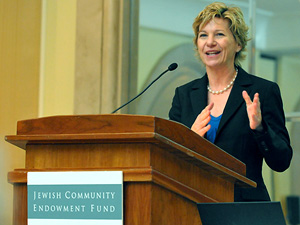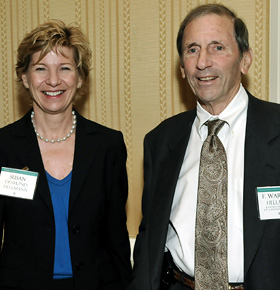Health Reform Must Include Push to Speed Innovation, Chancellor Says

Chancellor Sue Desmond-Hellmann gives the keynote speech at an Oct. 27 event hosted by the Jewish Community Endowment Fund.
The national debate over health care reform has focused primarily on insurance costs, while overlooking a crucial aspect of human health: translating scientific discoveries into widely used therapies, according to UCSF Chancellor Sue Desmond-Hellmann, MD, MPH.
In an Oct. 27 speech, “From Bench to Bedside: Innovation in the Era of Health Care Reform,” Desmond-Hellmann said that by speeding up the transformation of lab breakthroughs into innovative treatments, scientists will not only improve health outcomes, but also help contain rising health care costs.
However, she said, while translational science is vital to improving health around the world, it is currently “not done as well as it should be or could be.”
Desmond-Hellmann, the keynote speaker at the Jewish Community Endowment Fund’s 2009 Tax and Estate Planning Seminar, cited the example of Avastin, the first FDA-approved cancer therapy designed to inhibit angiogenesis, the process by which new blood vessels develop and carry nutrients to a tumor. The drug is manufactured by Genentech, where Desmond-Hellmann worked for 14 years before coming to UCSF.
The link between angiogenesis and cancer was first revealed in a 1971 article in the New England Journal of Medicine. But it wasn’t until 1989 that Napoleone Ferrara, MD, a former UCSF postdoctoral researcher working at Genentech, discovered the blood vessel growth factor VEGF, which plays a key role in tumor angiogenesis.
Eight years later, in 1997, Genentech started the first clinical trials of Avastin, an antibody that blocks VEGF, and in 2004 the drug was approved as a treatment for colon cancer. Since then, more than 500,000 patients with various types of cancer have been treated with Avastin, Desmond-Hellmann said.
“My question is why did it take us so long?” Desmond-Hellmann said of the 23-year bench-to-bedside timeline for Avastin.
Bridging Gap to Discovery
To bridge the gap between the discovery and practical application of scientific innovations, Desmond-Hellmann said researchers should focus on three goals.

Chancellor Sue Desmond-Hellmann stands with F. Warren Hellman, co-founder of the private equity investment firm Hellman and Friedman, at an Oct. 27 event hosted by the Jewish Community Endowment Fund.
The first goal, she said, is the more widespread use of “reverse translation,” in which the behavior of a disease in human patients helps inform and inspire future lab studies.
“We should know every time someone is treated with a medicine, exactly what happens,” she said, adding that tools such as electronic medical records can help doctors track patients’ experiences with a certain drug or therapy.
The second goal — the improved translation of discoveries — is tied to the current trend toward personalized medicine, Desmond-Hellmann said. For example, she said, it remains difficult to predict which patients will benefit from Avastin. But by understanding the genetics behind a patient’s cancer, doctors could determine on a case-by-case basis whether Avastin or another therapy was the best course of treatment, she said.
The final goal Desmond-Hellmann identified was more effective clinical trials. Trials can take years to complete, she noted, and during that time, participants’ health may take a sudden turn. Trial coordinators must be on the lookout for any changes in a patient’s condition and be able to “quickly switch gears, if necessary,” in terms of treatment, she said.
Desmond-Hellmann’s speech came one day after her first town hall meeting at UCSF, in which she singled out “patients and health” and “discovery” as two of her top priorities as chancellor. She said she firmly believes UCSF and its fellow research institutions in Northern California will lead the way in fostering innovation in the years to come.
The University is striving to “be a world leader in scientific discovery and its translation into exemplary health,” as spelled out in the UCSF Strategic Plan, which was released in 2007. For her part, Desmond-Hellmann says she is working on a business plan to help UCSF achieve its strategic plan.
“We have all the talent, all the tools,” she said on Oct. 27. “I’m very convinced we will be the best in the world at translational science.”
Photos by Peter Marcus/San Francisco
Related Links:
Chancellor to Focus on Four Priorities to Address Mission, Vision
UCSF Today, Oct. 26, 2009
The Clinical and Translational Science Institute at UCSF
Jewish Community Endowment Fund